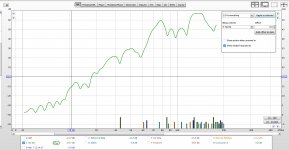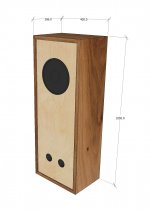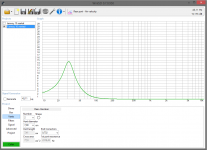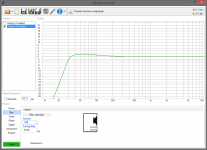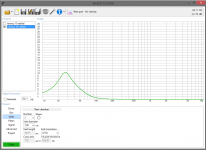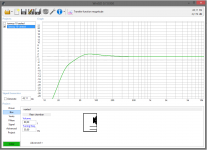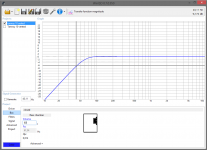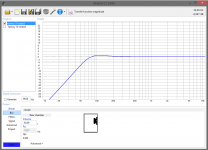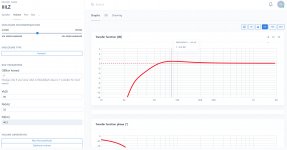I've built a couple of Dave's designs (mFonken and floorstander MKII) plus a sealed subwoofer, but this is a little different. At the suggestion of an audiophile friend, I found a pair of 10" Tannoy Monitor Gold dual concentric drivers on ebay. They're in their original cabinets and sounding great, but with little bass extension.
From what I've read and been told, all the Monitor Gold drivers left the factory in cabinets too small to really let them shine, I think these are about 40lt and sealed.
Troels Gravesen has a great write up of upgrading the crossovers, but he doesn't mention the box volume or tuning anywhere. I've emailed him but he's a busy guy, so far no reply.
He writes:

I have no experience designing boxes using T&S values, I don't even know what the numbers mean, but plugging them into Speakerbox Lite I think I'm getting close to what I want. You can have a look here.
Is this curve any good? I'd like to keep the volume around 75 to 80ltrs with two ports on the baffle. I'll be using 24mm birch ply with 18mm bracing, keeping the original crossovers for now, but externally mounted, thinking of going bi-amped in future.
Measuring my sub with REW I have room modes at 43Hz and 58Hz that cause dips, and a boost at 78Hz. That was with the sub tucked in the corner though, not sure how much difference that makes. To be clear, I won't be using the sub with the Tannoys - I'm showing it as a reference in case my room makes a difference to the box tuning.
In short - does 80lt tuned to 35Hz with two ports 46mm dia and 71mm long look ok? Is that curve acceptable?
Any and all advice is very welcome - I have no idea what I'm doing but I really want to give these fantastic drivers an opportunity to shine. There's almost no info on DIY cabinets for the 10" Monitor Golds (lots on 12" and 15") so hopefully this thread will be a source of knowledge for future builders.
From what I've read and been told, all the Monitor Gold drivers left the factory in cabinets too small to really let them shine, I think these are about 40lt and sealed.
Troels Gravesen has a great write up of upgrading the crossovers, but he doesn't mention the box volume or tuning anywhere. I've emailed him but he's a busy guy, so far no reply.
He writes:
but then his table shows slightly different results (his on the left, ignore blue ones on the right):My initial measurements suggest the following: Fs = 40 Hz, Vas = 80 litre, Re = 5.75 ohms, Qt = 0.5-0.6, Qe = 0.65, Qm = 4.4, Mmd = 25 grams
I have no experience designing boxes using T&S values, I don't even know what the numbers mean, but plugging them into Speakerbox Lite I think I'm getting close to what I want. You can have a look here.
Is this curve any good? I'd like to keep the volume around 75 to 80ltrs with two ports on the baffle. I'll be using 24mm birch ply with 18mm bracing, keeping the original crossovers for now, but externally mounted, thinking of going bi-amped in future.
Measuring my sub with REW I have room modes at 43Hz and 58Hz that cause dips, and a boost at 78Hz. That was with the sub tucked in the corner though, not sure how much difference that makes. To be clear, I won't be using the sub with the Tannoys - I'm showing it as a reference in case my room makes a difference to the box tuning.
In short - does 80lt tuned to 35Hz with two ports 46mm dia and 71mm long look ok? Is that curve acceptable?
Any and all advice is very welcome - I have no idea what I'm doing but I really want to give these fantastic drivers an opportunity to shine. There's almost no info on DIY cabinets for the 10" Monitor Golds (lots on 12" and 15") so hopefully this thread will be a source of knowledge for future builders.
Attachments
Last edited:
There's quite a big difference between the left and right (blue) T/S parameters. I wonder if the (fabric?) surround has gone stiff over the years?
I wouldn't worry about the blue parameters, there's no source, could be from anywhere.
Troels' drivers are the same age as mine and he's an expert on these things - I'm trusting his T/S.
Troels' drivers are the same age as mine and he's an expert on these things - I'm trusting his T/S.
This driver needs a much larger box to go low i see with the specs (i used those of Troels) you give. A 150L ported with a round port of 10cm diameter and 15cm long gives a decent flat response i think. 80L is way to small for that, and you won't have and F3 of 35, but more somthing like 40Hz with a big 3dB bump in the response between 60 and 150Hz. if you still do an 80L cabinet, use a single 10cm round port of 16.7cm tells winisd me...
And as XMAX is not stated, it's hard to tell that this will really be the case for this driver. If i use a guessed xmax of 2.5mm (typical for this kind of drivers), the bass response cuts off at 100dB (8W) and full power (15w), there is a sharp cut at 80Hz due to that.
Best is to use something like DATS and measure the driver, so you have more specific data for these drivers you got. Age and (ab)use change the T/S parameters, sometimes a lot, so working on published specs with old drivers is guessing blind.
And sealed with the specs you mention, a QTC of 0.707 (F6 of 40Hz) needs a 194L cabinet, the 40L gives a QTC of 0.959 and an F6 of 50Hz
And as XMAX is not stated, it's hard to tell that this will really be the case for this driver. If i use a guessed xmax of 2.5mm (typical for this kind of drivers), the bass response cuts off at 100dB (8W) and full power (15w), there is a sharp cut at 80Hz due to that.
Best is to use something like DATS and measure the driver, so you have more specific data for these drivers you got. Age and (ab)use change the T/S parameters, sometimes a lot, so working on published specs with old drivers is guessing blind.
And sealed with the specs you mention, a QTC of 0.707 (F6 of 40Hz) needs a 194L cabinet, the 40L gives a QTC of 0.959 and an F6 of 50Hz
Last edited:
Thanks for your help waxx. Unfortunately I don't have the space for 150ltr cabinets - do you think 80ltrs is worth it? I don't need huge amounts of bass extension, just enough to let the speakers do their thing and balance the HF. Tight punchy bass is better than going really low.
Can you help me understand why Troels says "Fs = 40 Hz, Vas = 80 litre" in the body of his text but the table shows Fs: 44Hz and Vas: 65ltrs?
Which did you use to get the 100mm x 167mm port in an 80ltr cabinet? Aesthetically I'd prefer two ports - is this a bad idea for performance?
I've measured the current sealed cabinets and they are 40ltr (allowing for wall thickness and volume of driver). Do you think an 80ltr ported box produce a much better sound, worth the build?
I know measuring the actual drivers would be best but don't really want to spend ~200 euro on a testing system... especially when I don't actually understand the results.
Can you help me understand why Troels says "Fs = 40 Hz, Vas = 80 litre" in the body of his text but the table shows Fs: 44Hz and Vas: 65ltrs?
Which did you use to get the 100mm x 167mm port in an 80ltr cabinet? Aesthetically I'd prefer two ports - is this a bad idea for performance?
I've measured the current sealed cabinets and they are 40ltr (allowing for wall thickness and volume of driver). Do you think an 80ltr ported box produce a much better sound, worth the build?
I know measuring the actual drivers would be best but don't really want to spend ~200 euro on a testing system... especially when I don't actually understand the results.
Thanks for your help waxx. Unfortunately I don't have the space for 150ltr cabinets - do you think 80ltrs is worth it? I don't need huge amounts of bass extension, just enough to let the speakers do their thing and balance the HF. Tight punchy bass is better than going really low.
Can you help me understand why Troels says "Fs = 40 Hz, Vas = 80 litre" in the body of his text but the table shows Fs: 44Hz and Vas: 65ltrs?
Which did you use to get the 100mm x 167mm port in an 80ltr cabinet? Aesthetically I'd prefer two ports - is this a bad idea for performance?
I've measured the current sealed cabinets and they are 40ltr (allowing for wall thickness and volume of driver). Do you think an 80ltr ported box produce a much better sound, worth the build?
I know measuring the actual drivers would be best but don't really want to spend ~200 euro on a testing system... especially when I don't actually understand the results.
I use WinISD software to model, it's free and easy to learn if you know the basics about speaker designing. WinISD - Linearteam
I use the average specs of the list of Troels, and model both sealed and vented. I made a few printscreens so you can see (and adapted vented to 2 port systems). You can also manually calculate that (like they did before computers) but modelling software got very good these days, and WinISD, Hornresp and VirtuaxCad are excellent freeware. They can fast tell you what is possible...
I would rather use an 80L sealed for this driver, it's better fit, and it goes reasonable low. For sealed, you need to look at F6 and F10 to know the response, not to F3 like with ported cabs.
Attachments
Last edited:
That's great, thanks waxx. I have a mac - all the speaker modelling apps seem to be windows unfortunately, hence using SpeakerBoxLite. Subwoofer box calculator, Sub box calculator
I guess I could build a sealed 80ltr with a removable panel so I can add / test vents later.
I guess I could build a sealed 80ltr with a removable panel so I can add / test vents later.
[annoying person mode] yeah, real egineers don't use mac, but windows and linux [/annoying person mode]
No, i'm joking, but it's true that little technical software is availeble for mac. I work in IT and mac is only used by salespeople (because it's fashionable) and graphic designers. The rest uses windows pc's. But you can easely make a VM with windows for mac if you do this more than once and use the modelling software in that VM. For that you need a windows licence altough. I did it all the time when i was working in my former job as IT admin for a engineering company that makes software and hardware for the advertising industry. And modelling software is way lighter than PLC control systems, for what we used those VM's for (on technical level).
No, i'm joking, but it's true that little technical software is availeble for mac. I work in IT and mac is only used by salespeople (because it's fashionable) and graphic designers. The rest uses windows pc's. But you can easely make a VM with windows for mac if you do this more than once and use the modelling software in that VM. For that you need a windows licence altough. I did it all the time when i was working in my former job as IT admin for a engineering company that makes software and hardware for the advertising industry. And modelling software is way lighter than PLC control systems, for what we used those VM's for (on technical level).
So I've settled on 80L tuned to 33Hz - 2x) 50mm dia ports, 103mm long. There's a ~1dB hump but I have to live with that, I don't have space for a 200L cabinet.
Before I start cutting things up I'd really appreciate any input from Dave (Planet10) or Scott (Scottmoose) - I know Dave has made an Onken style cab for an old Tannoy.
Would either of you suggest anything radically different than a ported enclosure?
Before I start cutting things up I'd really appreciate any input from Dave (Planet10) or Scott (Scottmoose) - I know Dave has made an Onken style cab for an old Tannoy.
Would either of you suggest anything radically different than a ported enclosure?
Attachments
I'm not Dave or Scott,
But i will suggest a different approach: do you want absolutely a 2 way with your Gold or are you open to a three way approach?
If ok for a three way go sealed for Gold's box and cross them around 250/300hz to a sub: this solve the issue of box size and keep large membrane excursion away from your coax cone ( you then mitigate the issue of modulating the horn signal by the now mid woofer- it serve as an extension of the 'horn' profile).
That way you keep the important 300hz to 6khz a point source and you lessen the real theorical issue of Tannoy coaxial approach. A side benefit not to forget is the mid won't leak through bass reflex port which overall make results cleaner.
Nothing new under the sun about that, it is recommended as a way to 'upgrade' this kind of loudspeaker by a lot of user here and this is the Way Tannoy implemented some of their 'high end' references ( Birmingham iirc and Dreadnough).
But i will suggest a different approach: do you want absolutely a 2 way with your Gold or are you open to a three way approach?
If ok for a three way go sealed for Gold's box and cross them around 250/300hz to a sub: this solve the issue of box size and keep large membrane excursion away from your coax cone ( you then mitigate the issue of modulating the horn signal by the now mid woofer- it serve as an extension of the 'horn' profile).
That way you keep the important 300hz to 6khz a point source and you lessen the real theorical issue of Tannoy coaxial approach. A side benefit not to forget is the mid won't leak through bass reflex port which overall make results cleaner.
Nothing new under the sun about that, it is recommended as a way to 'upgrade' this kind of loudspeaker by a lot of user here and this is the Way Tannoy implemented some of their 'high end' references ( Birmingham iirc and Dreadnough).
Thanks for your input krivium. I'd like to keep them as simple as possible really, having spent quite a lot on the Tannoys already I don't really want to spend even more on additional woofers. I don't even know where I'd start building a three way crossover, or the expense of that approach.
Aesthetically a single driver (although actually it's two) on the front of the cabinet is great, the conceptual simplicity appeals to me too.
I've got my sealed sub crossed at 90Hz just now (much too high but the current 40L sealed boxes don't have much below 100Hz). I'm hoping 80L ported cabinets will be fine for LF extension but I can always keep the sub if I really have to.
Aesthetically a single driver (although actually it's two) on the front of the cabinet is great, the conceptual simplicity appeals to me too.
I've got my sealed sub crossed at 90Hz just now (much too high but the current 40L sealed boxes don't have much below 100Hz). I'm hoping 80L ported cabinets will be fine for LF extension but I can always keep the sub if I really have to.
Unfortunately EBS alignment doesn't work unless you get into 150L territory - I'll build some mad big horn loaded things in future when I live in a huge detached house, for now they have to fit into our London flat.
Ot, the monitors i talked about are Buckingham not Birmingham... : rolleyes:
I thought Birmingham didn't sound very Tannoy prestige...
- Home
- Loudspeakers
- Multi-Way
- Bass Reflex Design for 10" Tannoy Monitor Gold IIILZ
